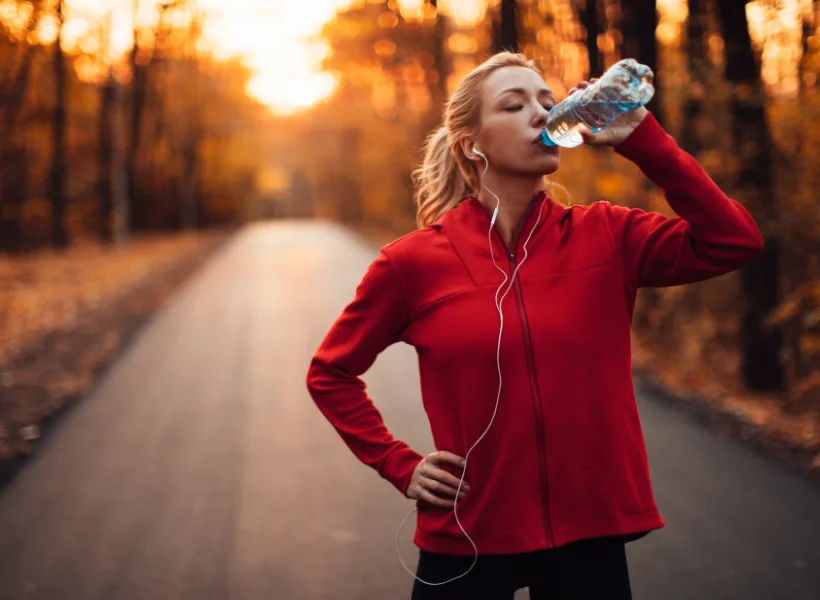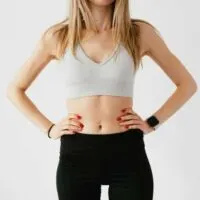Selecting the right workout clothes is crucial for any fitness routine. The right attire can enhance performance, ensure comfort, and prevent injury.
Quality workout garments are crafted, considering three essential factors: the fabric, the fit, and the function. These elements work together to provide the wearer with a garment that looks good and supports the body’s needs during physical exertion.
The fabric should facilitate wicking away sweat, the fit must allow freedom of movement without restriction or distraction, and the function is ensured through features like breathability, durability, and supportive technologies.

Understanding the materials used in workout clothes is crucial, as they can have a considerable impact on the effectiveness of one’s exercise regimen.
Technical fabrics with moisture-wicking properties keep the body cool and dry, while stretchable blends offer the necessary flexibility.
The fit of the garment is equally important, enabling full range-of-motion and reducing the risk of chafing or discomfort.
Moreover, additional functional features like reflective elements for safety, compression to enhance circulation, or pockets for convenience should be considered when selecting high-performance workout wear.
Key Takeaways
- Quality workout attire must be made of appropriate fabrics that manage sweat and provide flexibility.
- Proper fit is essential for comfort and to ensure unrestricted movement during exercise.
- Functional features in workout clothes can enhance performance and safety.
Understanding Fabric Choices for Workout Clothes
Choosing the right fabric for workout clothes is crucial as it affects comfort, performance, and durability. Specific materials offer different benefits, such as moisture-wicking, breathability, and flexibility.
The Importance of Fabric in Performance
The fabric of workout clothes heavily influences an athlete’s comfort and efficiency. Breathable fabrics allow for better air circulation, helping to regulate body temperature during intense workouts. This is critical because overheating can impair performance and cause discomfort.
Similarly, fabrics with moisture-wicking properties draw sweat away from the body, aiding in temperature regulation and reducing the risk of skin irritation.
Common Materials and Their Properties
Cotton is a traditional choice for its natural, soft feel and breathability, but it retains moisture and can lead to discomfort and chafing.
On the other hand, synthetic materials such as polyester and nylon are praised for their strength, quick drying, and minimal absorption qualities.
- Polyester: Durable, lightweight, and moisture-resistant
- Nylon: Exceptionally strong, mildew-resistant, and quick-drying
- Spandex: Known for its exceptional elasticity
Workout enthusiasts often prefer a blend of these materials to maximize comfort and function.
Technical Fabrics and Modern Innovations
Advancements in fabric technology have introduced materials like Lycra and recycled polyester into the activewear market.
Lycra, a type of spandex, offers significant stretch and shape retention, enhancing fit and flexibility.
Recycled polyester affords an eco-friendly alternative without compromising on moisture management or durability.
Polypropylene and bamboo fibers are also emerging as options, with properties such as odor resistance and an eco-conscious footprint.
Additionally, merino wool is establishing a niche for itself as a temperature-regulating, breathable fabric that can wick moisture while being soft and natural.
The Role of Fit in Workout Clothing
The fit of workout clothing is essential for both functionality and comfort during exercise. It ensures that the attire adheres to the body’s movements and supports various physical activities without restriction.
Different Types of Fits for Various Activities
When selecting activewear, it’s important to consider the type of exercise as different activities demand different types of fit.
For instance, yoga practitioners often prefer leggings with a snug, stretchy fit, which allows for greater flexibility and freedom of movement. On the other hand, loose-fitting clothing might be the choice for activities like running or aerobics for better air circulation.
- Compression wear, such as compression leggings and sports bras, is designed to support muscles during exercise, potentially improving performance and reducing muscle fatigue.
- Cyclists may opt for form-fitting clothing to reduce air resistance and increase efficiency.
- CrossFit enthusiasts might look for a balance between compression and flexibility to accommodate a wide range of activities, from weightlifting to sprints.
Finding the Right Size and Style
The right size and style of workout clothing will differ for each person, reflecting their personal style and ensuring they feel comfortable and confident. Here are specific aspects to consider:
- A proper fit means the garment should be neither too tight nor too loose; it should contour to the body without constricting movement or circulation.
- Sports bras should offer sufficient support without digging into the skin, whereas leggings and shorts should allow for a full range of motion without sliding or rolling down.
| Activity | Suggested Fit |
|---|---|
| Yoga | Stretchy, form-fitting |
| Running | Loose and airy |
| Weightlifting | Non-restrictive, moisture-wicking |
| Cycling | Aerodynamic, snug |
Functional Features of Quality Workout Attire
Quality workout attire is engineered to meet the rigorous demands of physical activity, enhancing performance and comfort through advanced fabric technology, meticulous construction, and thoughtful design details.
Breathability and Moisture Management
Workout garments must allow for ventilation to help regulate body temperature during exercise.
High-quality pieces use breathability and moisture-wicking fabric that draw sweat away from the body, allowing it to evaporate quickly. This not only keeps the wearer dry and comfortable but also prevents bacterial growth and odor.
- Materials: Polyester, Nylon
- Benefits: Dryness, Odor control
Seamless Construction and Durability
The integrity of workout clothes is crucial—they must withstand repetitive movements and the stress of various exercises.
Seamless construction reduces the risk of irritation and chafing, providing a smooth fit that moves with the body. Additionally, reinforced stitching and high-density fibers contribute to the durability of the attire, ensuring that it maintains shape and functionality over time.
- Features: Reinforced stitching, High-density fibers
- Advantages: Reduced irritation, Long-lasting wear
Flexibility and Compression Elements
Quality workout attire offers a balance between flexibility and support.
Incorporating compression elements can improve circulation and muscle support, potentially enhancing performance and recovery. These features allow for a full range of motion while still providing a snug, supportive fit that aligns with the wearer’s workout needs.
Performance and Comfort: The Ultimate Duo

Quality workout clothes achieve a delicate balance between enhancing performance and providing comfort. Technical fabrics and design innovations play pivotal roles in meeting these demands.
Balancing Function and Comfort in Design
When it comes to activewear, the intersection of function and comfort is crucial. High-performance workout clothing is designed with activities’ intensity in mind, ensuring that functionality is not sacrificed for comfort.
Technical fabrics offer breathability and moisture-wicking properties, which are indispensable for keeping a person dry and cool during intense workouts.
Moreover, strategically placed seams, compression technology, and ergonomic cuts optimize the range of motion and reduce the risk of chafing, enhancing the overall workout experience.
Comfort also factors into the design process through the integration of soft, yet durable materials that conform to the body’s shape.
Activewear brands are increasingly using eco-friendly materials, providing added comfort to consumers who value transparency and sustainability.
The trend towards eco-consciousness in the industry not only supports the environment but also resonates with customers who are mindful of their carbon footprint.
- Performance Design Features:
- Breathable fabrics
- Moisture management
- Compression zones
- Reduced seam friction
- Comfort Design Features:
- Soft-touch materials
- Adaptive fit
- Non-irritating seams
- Eco-conscious textiles
Comfort Enhancements in Modern Workout Apparel
Modern workout apparel has come a long way in terms of enhancing comfort without compromising on performance.
Advanced textile innovation has led to the creation of fabrics that regulate body temperature, such as those incorporating phase change materials, which can be found in the latest technical fabrics. This material adjusts to body heat and external temperatures, keeping wearers comfortable regardless of the workout environment.
Activewear brands continue to innovate by employing cutting-edge technology to increase comfort.
Features such as antimicrobial treatments and UPF protection are emerging as standard offerings, offering protection beyond the physical demands of workouts.
Tagless designs and flatlock seams enhance the wearability and comfort of workout clothing, ensuring that a person can focus on performance without distraction.
- Technologies Enhancing Comfort:
- Temperature-regulating fabrics
- Antimicrobial treatments
- UPF protection
- Design Elements for Comfort:
- Tagless labels
- Flatlock seams
- Stretchable weaves
Sustainable and Eco-Friendly Workout Wear
The shift towards more sustainable and eco-friendly workout wear has brought about new materials and a focus on ethical production methods.
These advancements are not just beneficial for the environment but also resonate with consumers who value transparency and responsibility in their apparel choices.
Eco-Friendly Materials and Practices
Sustainable workout wear often includes fabrics made from eco-friendly materials such as organic cotton, bamboo, and recycled polyester.
Organic cotton is grown without harmful pesticides and uses less water compared to conventional cotton, making it a popular choice for eco-conscious brands.
Bamboo is renowned for its soft texture and biodegradability, and when harvested sustainably, it reduces environmental impact.
Recycled polyester is another critical component in eco-friendly workout clothing.
It reduces plastic waste by repurposing existing synthetic materials, such as plastic bottles, into high-quality fabric.
This not only prevents additional plastic from entering landfills but also requires fewer resources during production, such as water and energy, compared with virgin polyester.
- Advantages of Recycled Polyester:
- Reduces landfill waste
- Requires less energy and water to produce
- Decreases reliance on petroleum as a raw material
Moreover, brands are adopting practices that minimize the environmental footprint, such as water-saving dye techniques, energy-efficient manufacturing processes, and waste-reduction methods.
Transparency and Ethical Production
Transparency in the production of workout clothing is essential for both ethical and environmental reasons.
Brands that practice transparency often provide information about their supply chains, from sourcing of raw materials to the manufacturing processes.
They openly share details regarding their workers’ conditions, showcasing their commitment to ethical labor practices.
Ethical production also involves ensuring that all workers throughout the supply chain are treated fairly and work in safe conditions.
It implies fair wages, reasonable working hours, and the absence of child labor.
Brands that emphasize ethical production may also invest in community initiatives that support the wellbeing and development of workers and their families.
Trendsetting with Athleisure and Gym Fashion
Athleisure has evolved into a stylish hybrid of gym wear and casual fashion, reflecting a lifestyle dedicated to comfort and fitness.
Contemporary gym attire now makes a bold fashion statement, encapsulating performance and style.

Athleisure: Blurring Lines Between Workout Wear and Casual Fashion
Athleisure clothing is a testament to versatility and fashion coalescence, where functionality meets casual chic.
Originally designed for workouts, these pieces are now stylish enough for social events and the professional environment.
They are characterized by lightweight fabrics that offer ease of movement while looking effortlessly fashionable.
By incorporating high-quality materials, athleisure provides the durability needed for exercise, yet the style and comfort desired for everyday wear.
Leading brands have introduced trend-setting activewear, merging technical fabrics with contemporary design elements to satisfy the dual demands for fashion and function.
Gym Wear as a Fashion Statement
Gym wear is no longer confined to the realm of fitness centers. It has emerged as a symbol of modern-day sportswear fashion, embodying the traits of high-performance attire with an added focus on aesthetic appeal.
The trend has evolved to a point where gym outfits are as much about personal style as they are about sweat-wicking or support features.
With bold patterns, vibrant colors, and sleek silhouettes, gym wear pieces, such as leggings and tank tops, make a statement that extends well beyond the workout.
They are commonly paired with non-active apparel to create dynamic, fashion-forward ensembles suitable for various occasions.
Choosing Workout Clothes for Different Intensity Levels

Selecting the right workout apparel enhances performance and comfort. The materials and design should correspond to the workout’s demand on the body.
Apparel for High-Intensity Workouts
For high-intensity workouts, one should look for gym clothes that offer compression and moisture-wicking capabilities.
Compression wear can improve blood flow and reduce muscle fatigue.
High-intensity activities like HIIT or spin classes generate a lot of sweat, so clothing made with synthetics such as polyester or nylon is beneficial because they are engineered to draw moisture away from the body, helping to keep the wearer dry and prevent chafing.
- Fit: Clothes should be snug enough to support the muscles without restricting movement.
- Fabrics: Look for high-tech, breathable fabrics that can handle sweat and reduce odor.
- Functionality: Features like mesh panels can provide extra ventilation.
Gym gear with flatlock seams reduces irritation, and a gusseted crotch allows for better range of motion.
Clothing Options for Low-Intensity Exercise
For low-intensity workouts, comfort and flexibility are key.
During activities like yoga or walking, the body’s temperature increases more slowly, which means breathability and softness take precedence over sweat management.
- Fit: Apparel should offer a relaxed fit, allowing for full range of motion.
- Gym Clothes: Natural fibers like cotton can be suitable for these workouts as they feel soft against the skin and offer breathability.
- Function: Look for stretchable fabrics that move with the body.
While workout intensity varies, always consider the type of layering pieces that can transition comfortably between different exercises and surrounding temperatures.
Aftercare: Maintaining Your Workout Wardrobe
Maintaining workout clothing is crucial for ensuring their durability and continued performance. High-quality workout garments demand specific care to preserve their fabric integrity, fit, and functional properties.
Proper Cleaning and Care for Longevity
Fabrics: Different materials require distinct care methods.
For moisture-wicking garments, it’s advised to use cold water as it helps maintain the fabric’s moisture management properties.
Avoid fabric softeners; they can coat the fabric and reduce its wicking ability.
- Washing: Turn clothes inside out before washing to protect colors and reduce pilling. Secure all closures to prevent snagging.
- Detergent: Opt for a sports detergent or a mild detergent to protect the material’s fibers.
Cycle: Use a gentle cycle and avoid overloading the washing machine. The excess motion can stretch fibers and wear them out.
- Drying: Air-dry activewear on a flat surface or hang them up. High heat from dryers can break down fibers and compromise the garment’s fit and elasticity.
Washing Frequency: Excessive laundering can reduce a garment’s lifespan. Clean them when they are dirty or after heavy sweating.
Storage and Handling of Activewear
Folding vs. Hanging: To avoid stretching, fold items like leggings and yoga pants. For items that maintain shape better when hung, such as sports jackets and some tops, use wide-shouldered hangers.
- Storage Space: Store in a cool, dry place to prevent mildew and odor. If using a drawer or bin, consider adding dividers to keep clothing separated and organized.
Care Between Washes: Post-workout, air out garments before tossing them in the laundry bin to prevent bacteria growth and odor.
Conclusion

When selecting workout apparel, consumers should prioritize the trifecta of fabric, fit, and function.
The materials used in activewear such as moisture-wicking fabrics play a crucial role in enhancing the workout experience by keeping individuals dry and comfortable. The relevance of fabric choice is underscored in a new materialist analysis of activewear, which posits that material properties are vital for a satisfying fitness regime.
Moreover, fit is more than a matter of comfort; it’s about ensuring safety and efficiency in movement. Clothing that is too tight can restrict movement, while too loose can lead to accidents. The intricate balance of design features—such as stretchability and compression—is highlighted in studies like the one on consumer activewear experience.
The functionality aspect encompasses the practicality of the clothes in varied scenarios; some may favor leggings that transition from the gym to casual errands. Moreover, the interaction of clothing with physical activity suggests that the right workout gear can indirectly influence cognitive skills and overall academic performance in young individuals.
Frequently Asked Questions
Quality workout clothes can significantly enhance performance by offering the right blend of fabric, fit, and function. Each element plays a critical role in ensuring comfort, efficiency, and longevity of the apparel during vigorous activities.
How does fabric type impact performance in workout apparel?
The type of fabric is fundamental in workout apparel as it affects sweat management, comfort, and range of movement. For instance, synthetic materials like polyester deliver excellent moisture management, keeping the skin dry by wicking sweat away, which is crucial during intense workouts.
What features in workout clothing provide the best fit for active movement?
Workout clothing must accommodate a wide range of movements while maintaining its shape and position. Features like elastane in fabrics ensure flexibility and a snug fit, which can help athletes move freely without the clothes riding up or constricting their motion.
What characteristics define the functionality of high-quality sportswear?
Functionality in sportswear is defined by its ability to cater to specific sports needs. For instance, ergonomic design, sweat-wicking properties, and appropriate fit are all factors that work together to enhance athletic performance and comfort during exercise.
Which fabric materials offer the optimal balance of breathability and durability for gym wear?
Materials such as nylon and polyester combined with spandex often deliver a balance of breathability and durability, making them ideal for gym wear. They are resistant to tears and abrasions while offering airflow to help regulate body temperature.
How do you choose between natural and synthetic fabrics for fitness attire?
Choosing between natural and synthetic fabrics depends on the activity and personal preference. Whereas natural fabrics like cotton are soft and hypoallergenic, synthetic fabrics often provide superior moisture-wicking and quick-drying properties which are beneficial during sweaty workouts.
What should be considered when comparing moisture-wicking capabilities of different workout fabrics?
When evaluating moisture-wicking capabilities, one should consider the fabric’s ability to move sweat away from the skin. Also, consider how quickly it allows the moisture to evaporate.
Superior wicking fabrics can help maintain the body’s thermal regulation during exercise. This prevents overheating and discomfort.



